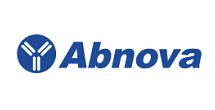F7 & F3 Protein Protein Interaction Antibody Pair



* The price is valid only in USA. Please select country.
-
More Files
- More Functions
-
Specification
Product Description
This protein protein interaction antibody pair set comes with two antibodies to detect the protein-protein interaction, one against the F7 protein, and the other against the F3 protein for use in in situ Proximity Ligation Assay. See Publication Reference below.

Reactivity
Human
Quality Control Testing
Protein protein interaction immunofluorescence result.
Representative image of Proximity Ligation Assay of protein-protein interactions between F7 and F3. HeLa cells were stained with anti-F7 rabbit purified polyclonal antibody 1:1200 and anti-F3 mouse monoclonal antibody 1:50. Each red dot represents the detection of protein-protein interaction complex. The images were analyzed using an optimized freeware (BlobFinder) download from The Centre for Image Analysis at Uppsala University.
Supplied Product
Antibody pair set content:
1. F7 rabbit purified polyclonal antibody (100 ug)
2. F3 mouse monoclonal antibody (40 ug)
*Reagents are sufficient for at least 30-50 assays using recommended protocols.Storage Instruction
Store reagents of the antibody pair set at -20°C or lower. Please aliquot to avoid repeated freeze thaw cycle. Reagents should be returned to -20°C storage immediately after use.
-
Applications
In situ Proximity Ligation Assay (Cell)
-
Gene Info — F3
Entrez GeneID
2152Gene Name
F3
Gene Alias
CD142, TF, TFA
Gene Description
coagulation factor III (thromboplastin, tissue factor)
Omim ID
134390Gene Ontology
HyperlinkGene Summary
This gene encodes coagulation factor III which is a cell surface glycoprotein. This factor enables cells to initiate the blood coagulation cascades, and it functions as the high-affinity receptor for the coagulation factor VII. The resulting complex provides a catalytic event that is responsible for initiation of the coagulation protease cascades by specific limited proteolysis. Unlike the other cofactors of these protease cascades, which circulate as nonfunctional precursors, this factor is a potent initiator that is fully functional when expressed on cell surfaces. There are 3 distinct domains of this factor: extracellular, transmembrane, and cytoplasmic. This protein is the only one in the coagulation pathway for which a congenital deficiency has not been described. [provided by RefSeq
Other Designations
OTTHUMP00000012426|coagulation factor III|tissue factor
-
Gene Info — F7
Entrez GeneID
2155Gene Name
F7
Gene Alias
-
Gene Description
coagulation factor VII (serum prothrombin conversion accelerator)
Omim ID
227500Gene Ontology
HyperlinkGene Summary
This gene encodes coagulation factor VII which is a vitamin K-dependent factor essential for hemostasis. This factor circulates in the blood in a zymogen form, and is converted to an active form by either factor IXa, factor Xa, factor XIIa, or thrombin by minor proteolysis. Upon activation of the factor VII, a heavy chain containing a catalytic domain and a light chain containing 2 EGF-like domains are generated, and two chains are held together by a disulfide bond. In the presence of factor III and calcium ions, the activated factor then further activates the coagulation cascade by converting factor IX to factor IXa and/or factor X to factor Xa. Alternative splicing of this gene results in 2 transcripts. Defects in this gene can cause coagulopathy. [provided by RefSeq
Other Designations
FVII coagulation protein|OTTHUMP00000018733|OTTHUMP00000018734|coagulation factor VII|eptacog alfa
-
Interactome
-
Pathway
-
Disease
- +1-909-264-1399
+1-909-992-0619
Toll Free : +1-877-853-6098 - +1-909-992-3401
- sales@abnova.com
















